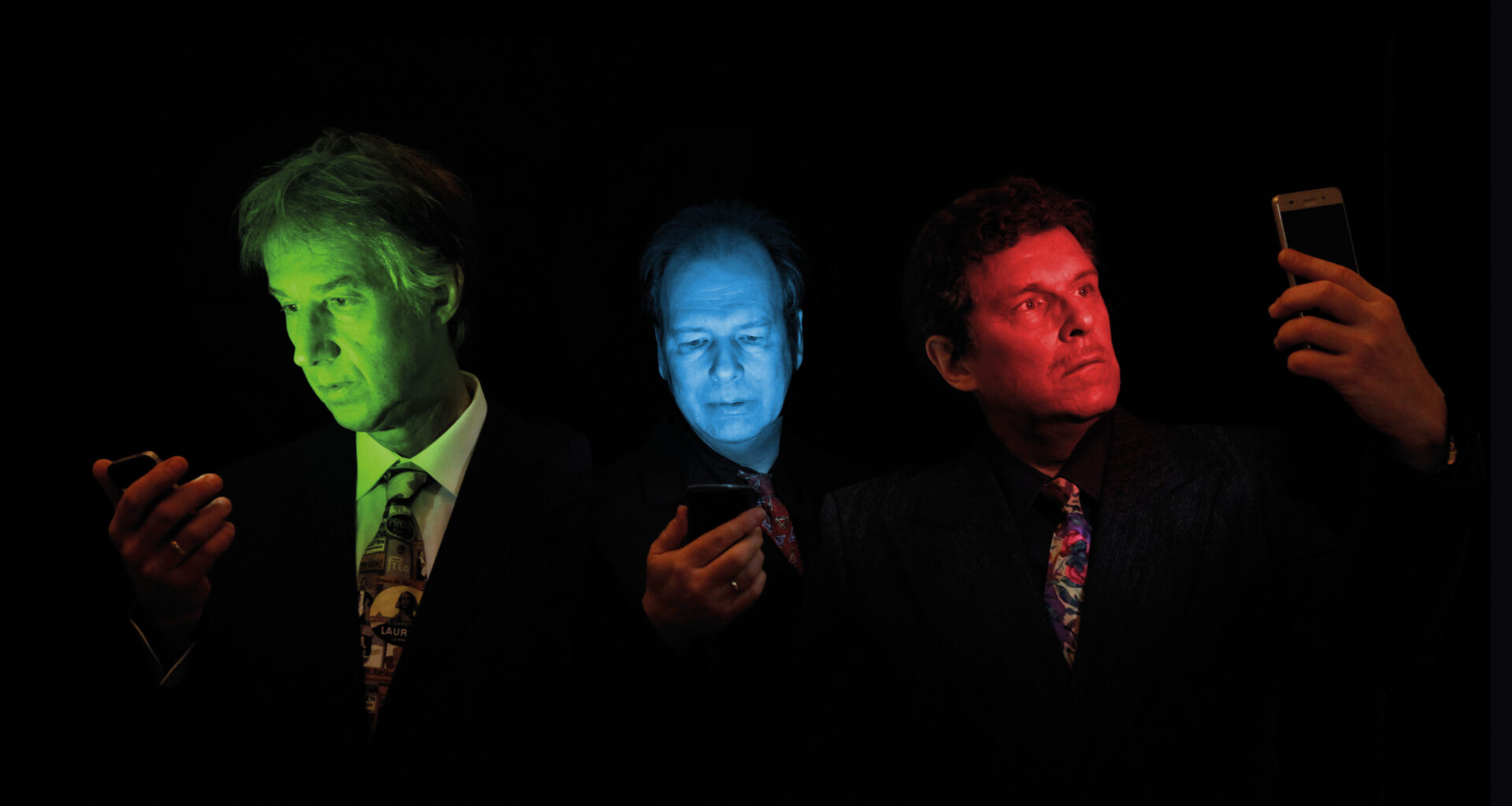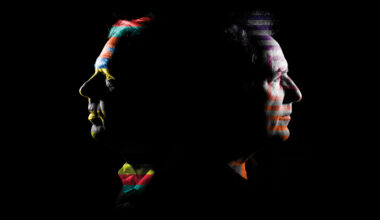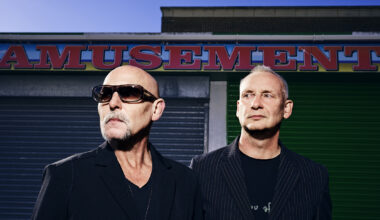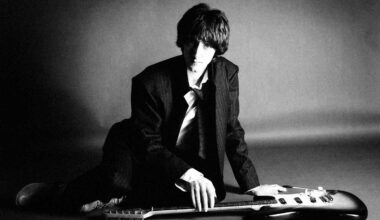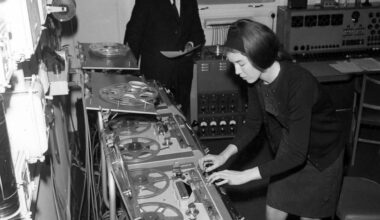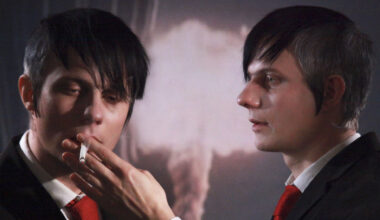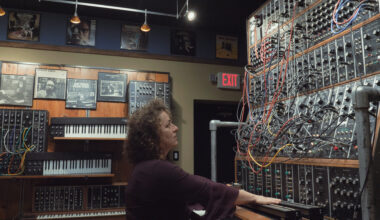After a mere quarter of a century hiatus, Düsseldorf’s avant-garde electro-schlager outfit Der Plan are back with a brand new album. We caught up with Kurt Dahlke and Moritz Reichelt for a trip back to the future
“More music into arts and more arts into music,” declares Kurt Dahlke, aka Pyrolator, one third of Der Plan, who emerged from the Düsseldorf post-punk scene of the late 1970s. It is the group’s clarion call. Despite their playfulness, their apparent kindergarten kitsch, and their cheerful acceptance of the “Neue Deutsche Welle” (New German Wave) tag imposed on them in the 1980s, a term bitterly rejected by sterner contemporaries such as Einstürzende Neubauten, Der Plan were always an artful proposition, born in the city that gave the world the likes of Kraftwerk and Neu!, as well as Joseph Beuys.
Having gone their separate ways in 1992, Der Plan decided to reform after a chance reunion. They’d never entirely given up on the idea of working together again; they understood that, despite impressions to the contrary, there will always be a tomorrow, different times to come. And given the barren, artless functionality of the 21st century pop plane, their conceptual, individualistic, seemingly dashed-off yet durable and highly thought-through electropop is more than welcome. It’s exemplary.
Der Plan’s new album, ‘Unkapitulierbar’, which means something like “Uncapitulable” and signifies “continuity and unbrokenness”, is based on cumulative sketches and ideas stored away over the years, ready for a sunny day. You’ll be pleased to hear that the group’s ethos has never disintegrated. From the multiple, zig-zag, spiralling, shiny rhythms of ‘Wie Der Wind Weht’ to the squelchy glissandos of ‘Lass Die Katze Stehn’, from the processed mandolins of the faux schlager ‘Es Heisst Die Sonne’ to the cursory yet richly suggestive synth brushstrokes of ‘Gesicht Ohne Buche’, this is an album that feels as necessary in 2017 as their debut was in 1980.
“I was a painter before I started making music,” says Moritz Reichelt, aka Moritz R, who along with Frank Fenstermacher makes up the rest of Der Plan. “When we first thought about live gigs for the group, painting was always an option. I saw the stage as a place on which things could be seen as well as heard.”
ormed in 1979, Der Plan were part of a scene that also Fincluded Deutsch Amerikanische Freundschaft, Die Toten Hosen, Liaisons Dangereuses, Fehlfarben and the aforementioned Einstürzende Neubauten, among others. These were groups with a very specific West German take on new music. Moritz, however, is clear that they did not see themselves as representing a continuation of the 1970s krautrock movement.
“In 1980, I literally didn’t know about Kraftwerk,” he says. “This German music that was known as krautrock wasn’t popular at all in Germany. Even when I first heard Kraftwerk, I wasn’t that interested in them.”
In common with Kraftwerk, however, Der Plan have a desire to rearrange the structure of the pop song, rather than follow preset, commercial lines.
“Exactly,” agrees Moritz. “Any song can have its own style. That’s what I learned from The Beatles’ ‘White Album’. I was 13 when I heard that and I was amazed by the diversity of styles. It was an education to me.”
“For me, it wasn’t really the German bands either,” adds Kurt. “My major influences were Pere Ubu and Chrome, as well as British artists like Wire, Throbbing Gristle and, of course, Daniel Miller.”
Nevertheless, again like Kraftwerk, Kurt at least felt like he was reconnecting with early 20th century German traditions. He admits to being influenced by the Triadisches Ballett (Triadic Ballet), for example, which premiered in Stuttgart in 1922, developed by Oskar Schlemmer and with music by German composer Paul Hindemith, whose work was described in its own time as “motorik”. Kurt particularly appreciated the ballet’s onstage “happenings”, in which painted theatrical masks and wild headgear featured strongly, as they did with Der Plan’s early live shows.
“I was into the Old Masters back then,” notes Moritz, who was not quite as conscious of the 20th century avant-garde. “Rubens, much more so than Neu!, was a superhero to me in 1978. I’m glad I didn’t know about this stuff, because back then I had to be convinced that I was the first person to do this, the first to ever paint cardboard on a stage! If I’d seen that those things already existed, I’d have refrained from doing them. Thank goodness for the ignorance of the pre-internet days.”
What immediately helped Der Plan into being was the musical and cultural impact of UK punk, which gradually crossed the Channel and made its way into Europe, and the new availability of cheap electronic hardware flooding in from Japan.
“At that time, I felt suddenly that things were happening from all over the world – Britain, France, Italy, Africa,” recalls Moritz. “A friend of mine made a film called ‘Punk In London’, which was shown in the movie theatres in Germany, including in my hometown of Oberthal in 1978. No one knew about punk at that time and it represented a big change, especially the way that music was produced. I was playing with DAF and we were going to see the record companies, but none of them were interested. Then we heard about the independent music scene in Britain and we thought, ‘Why don’t we produce it and release it ourselves on our own label?’. And that’s how our own record label, Ata Tak, was started.”

Kurt, the most musical of the Der Plan trio, meanwhile ordered an MS-20 synthesiser, an instrument that brought electronic music technology within the grasp of a new generation for whom the vast banks of synths displayed by the likes of Tangerine Dream felt both alienating in their ambient grandiosity and beyond their reach financially. But even with the MS-20, Der Plan’s equipment was desperately basic.
“With the first Der Plan album, we had one tape recorder, one mic, one synth,” says Kurt.
Despite these limitations, albums like 1980’s ‘Geri Reig’ and 1981’s ‘Normalette Surprise’ saw Der Plan creating a series of electropop miniatures, sparely drawn yet vividly atmospheric. The group’s use of odd tangents and spliced interpolations of field recordings, usually courtesy of Kurt’s Dictaphone, gave insights into strange, whole, tiny worlds.
“Lyrically, our ideas have always come from everywhere, from any type of situation, from anything at all that is going on in the world,” says Moritz. “We are completely open.”
There’s a unique sensibility about early Der Plan, with mirth and menace jostling unnervingly on tracks like ‘Gefährliche Clowns’ from ‘Geri Reig’ or the sing-song existentialism of ‘Meine Freunde’ from ‘Normalette Surprise’. There’s a spooky equivalence to the cardboard, cartoon menace of the group’s sets to Robert Wiene’s expressionist cinematic masterpiece ‘The Cabinet Of Dr Caligari’, reinscribed in an avant pop vein.
Moreover, as with DAF, Der Plan exude an oblique sense of humour that doesn’t easily translate and yet is somehow the more intriguing for it.
“Singing in German was a new thing,” says Moritz. “But that also came from punk. I could see how audiences related to German punk bands when they sang in German and that was something different for me. Before this, people would like a band for its musical side, so the idea of the directness of punk lyrics was shocking.”
Soon after the establishment of their Ata Tak label, Der Plan began to make connections with a fresh form of pop in Germany. It was not a million miles away from the schlager for which the country has long been famous. “Schlager” merely means “pop” or “hit”, but in the context of Germany it has a particular, folksy, escapist resonance that made it anathema to the experimentalists of the 1970s, artists who sought to forge in metal and electric, amid the cultural ruins of post-war Germany, a new music that was neither nostalgic nor amnesiac. For Moritz, however, Der Plan’s engagement with schlager, albeit an ironically charged one, was not a problem.
“In the 1930s, schlager was operetta, in the 50s it was rock ’n’ roll, in the 70s it was bombastic rock,” he explains. “It changed with the styles that were all over the world, but it always had a German touch to it. Today, it’s like techno. I don’t have the slightest problem with pop music. I like a good song. I mean, even though Frank Zappa was very avant-garde, he also always had these very catchy tunes.”
It was around this time that Der Plan began to dub their music “electro-schlager”. Through Ata Tak, they formed an association with Andreas Dorau, who had his first hit when he was barely out of his mid-teens with ‘Fred Vom Jupiter’, the deceptive quirkiness and swaying gait of which represented the inauguration of the Neue Deutsche Welle genre. Dorau was more radio friendly than Der Plan and possibly considered an irritant by some, but he was part of the same continuum as the Düsseldorf trio and also worked with left-field figures like Holger Hiller.
It was at Andreas Dorau’s 50th birthday party in 2014 that Kurt Dahlke, Moritz Reichelt and Frank Fenstermacher decided to start working together again. Der Plan enjoyed some success during the 1980s, not least with the brilliant ‘Da Vorne Steht ’Ne Ampel’, which could glibly be said to occupy a mid-point between Dada and Nena’s ‘99 Red Balloons’, but they had always been fitful as a group. “We only wanted to make records when we felt we had something to say,” they state. They all had side projects on the go too, with Moritz designing sleeves for the likes of Depeche Mode and Kurt working as a producer. Kurt also continued to record as Pyrolator, showcasing a host of innovations along the way, including the Brontologic sequencer.
There have been various attempts to keep the Der Plan brand alive over the last 25 years, most recently with 2004’s ‘Die Verschwörung’ album, which was a Moritz R enterprise featuring ‘Ulrike’, an anti-tribute to the Baader-Meinhof Group, a musical equivalent of Gerhard Richter’s famously detached images of the terrorist organisation. Still, for decades, the group felt like fish out of pop water.
“In 1992, it seemed like everyone was into techno and house, so there was no place for Der Plan,” says Kurt.
In the post-pop era of 2017, however, there is no room for anybody and loads of room for everything. So welcome back, Der Plan. But will they take their show on the road once more?
“We want to be innovative onstage, so we have to find out what we can do,” says Kurt. “We have to think of something new and distinctive, and this might take a little time.”
“It’ll probably involve a bit more technology and a bit less painting,” adds Moritz.
‘Unkapitulierbar’ is released by Bureau B
